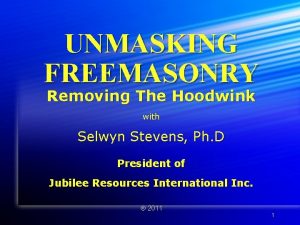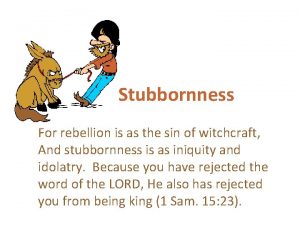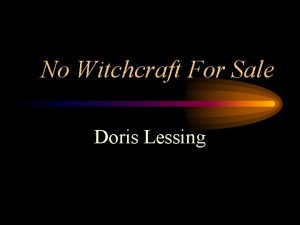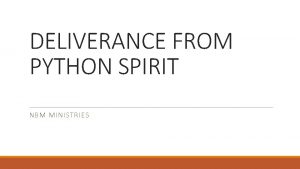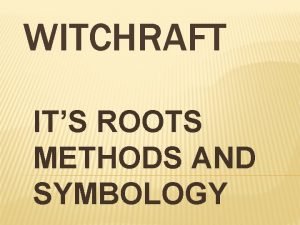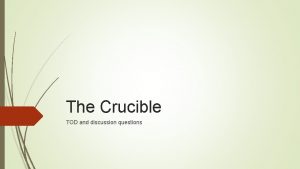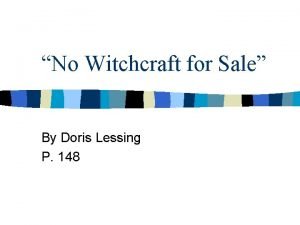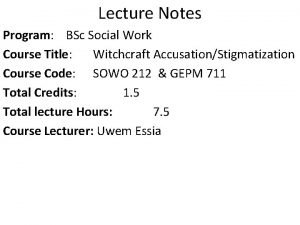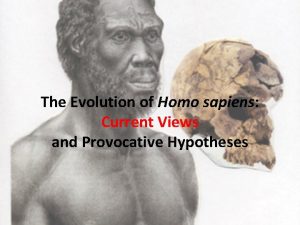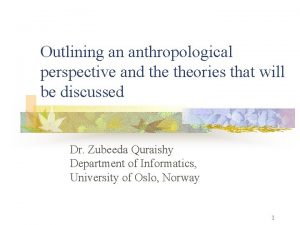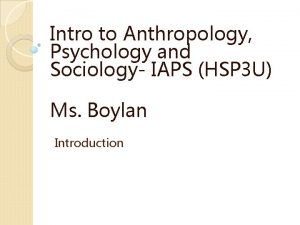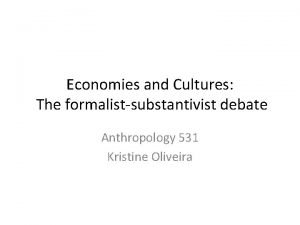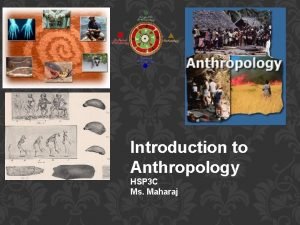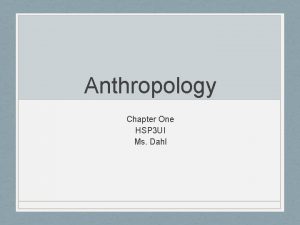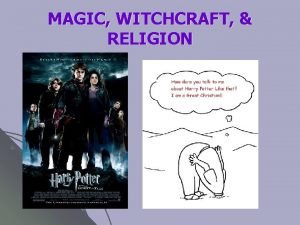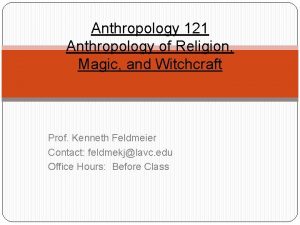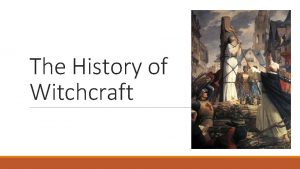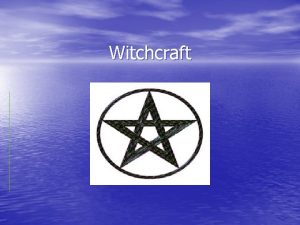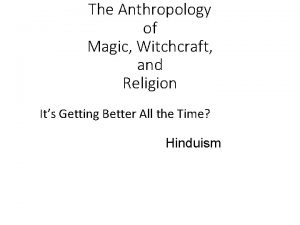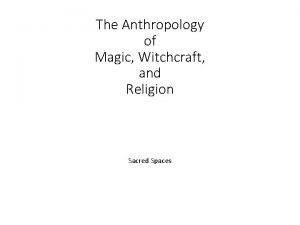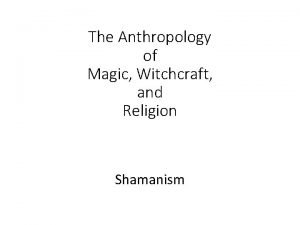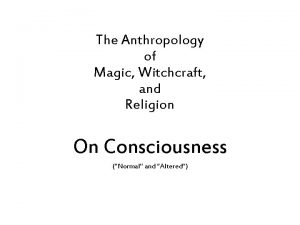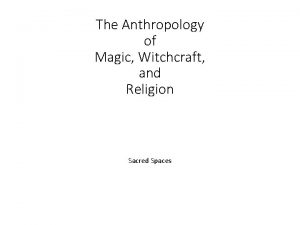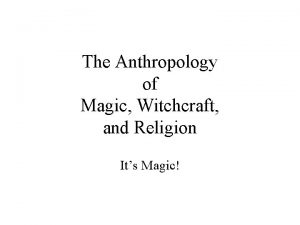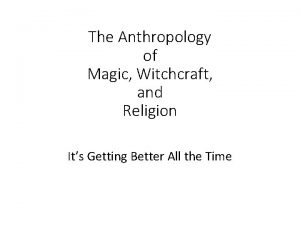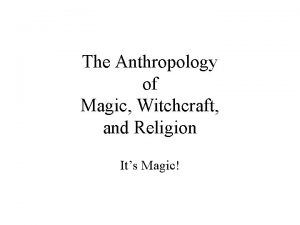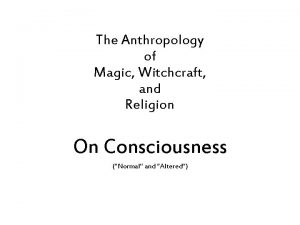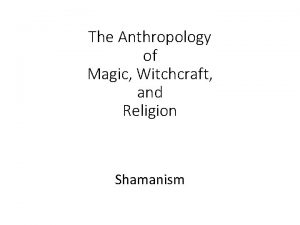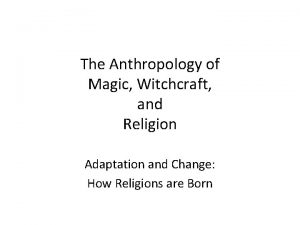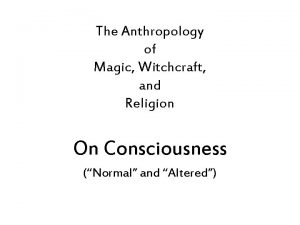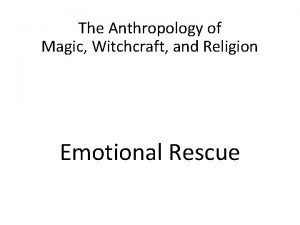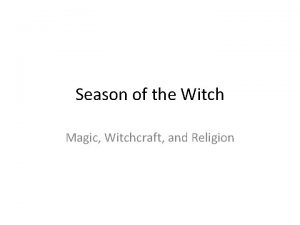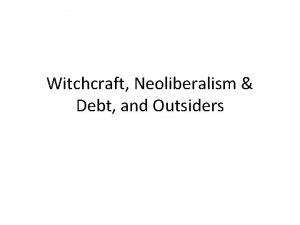The Anthropology of Magic Witchcraft and Religion The























- Slides: 23

The Anthropology of Magic, Witchcraft, and Religion The Structures of Religion

“How does one recognize a religion? Why does one say that certain behavior is religious? The answer lies in the fundamental pattern, or structure, which the layman and the ethnographer alike recognize when they look at a society and which, whenever it is found, is called ‘religious, ’ despite the manifold diversity of its forms. ” Anthony F. C. Wallace Religion: An Anthropological View 1966, page 52

13 categories of religious behavior 1. 2. 3. 4. 5. 6. prayer music physiological exercises exhortation reciting the code simulation 7. 8. 9. 10. 11. 12. 13. mana taboo feasts sacrifice congregation inspiration symbolism … the “smallest religious things” of a society

rituals • composed of varying numbers and sequences of the 13 categories of religious behavior • two basic types • calendrical • non-calendrical

calendrical rituals • occur on a regular schedule • related to an event in some natural cycle • day and night • lunar phases • solar cycles • positions of planets • almost always communal • attend to regularly occurring needs of the group

non-calendrical rituals • usually performed on occasions of crisis • often follow a life cycle calendar • birth • circumcision • marriage • death • may or may not be communal

beliefs • provide the justification for the rituals • two components • cosmology • pantheon (list of supernatural beings) • myths (narratives which tell of events in the careers of supernatural beings) • substantive beliefs (about planes of existence and the relations of causes and effects) • values

rituals, together with the beliefs that substantiate them, form cult institutions: “a set of rituals all having the same general goal, all explicitly rationalized by a set of similar or related beliefs, and all supported by the same social group. ”

the “religion” of a society • consists of multiple cult institutions • not all of these cult institutions are equal in importance • each cult institution is more or less autonomous with regard to its • beliefs • rituals • history • cult institutions may influence one another

“American religion” 1. the organized denominations of an area • • Christian Jewish Moslem Hindu Buddhist Ba’hai Sikh etc.

“American religion” 2. the “religio-political” cult • • non-denominational theistic used to rationalize and sanction political, military, and other secular institutions expressed in • • • Pledge of Allegiance (“One nation, under God”) currency (“In God We Trust”) has its own rituals and beliefs

“American religion” 3. “superstitions” • • • good and bad luck “what goes around comes around” “justice will prevail” “on a roll” black cats, breaking mirrors, spilling salt, etc.

“American religion” 4. children’s cult • sanctioned by parents • believed only by children • • • Christmas (Santa Claus) Easter (Easter Bunny) Halloween

a society’s “religion” • NOT a • a summative notion • with one single unifying, coherent set of rituals and beliefs • which all members follow equally • but RATHER • a loosely related group of cult institutions • plus other, less well-organized special practices and beliefs

types of cult institutions 1. 2. 3. 4. individualistic shamanic communal ecclesiastical 1. Olympian 2. monotheistic

individualistic cult institutions • not performed by specialists each person enters into his or her own relationship with supernatural entities requires no intermediaries • examples: • • • vision quests hunting magic “luck” “children’s cult

shamanic cult institutions • • involve part-time practitioners involves simplest expression of religious division of labor • examples: • • • shamans proper diviners medicine men palm readers astrologers

communal cult institutions led by groups of laity • • who only occasionally carry out their cult roles are organized via a bureaucratic structure are not full-time specialists in these duties examples: • • puberty rituals ancestor ceremonies political functions (U. S. )

ecclesiastical cult institutions • most complex type • feature a professional clergy who are organized in a manner similar to the military, political, and economic institutions of the society • clergy undergo a formal training • clergy are formally elected or appointed

ecclesiastical cult institutions • clergy are full-time religious specialists • clergy is exclusively responsible for performing certain rituals on behalf of individuals, groups, or the whole community • clergy may claim authority over laity

ecclesiastical cult institutions Olympian Polytheistic a hierarchy of supernatural entities, each with a more or less independent character

ecclesiastical cult institutions Monotheistic all supernatural entities are Either subordinate to, or simply manifestations of one Supreme Being

So… Who’s your Daddy… …or your Mama?
 Belief in magic witchcraft and wizardry codycross
Belief in magic witchcraft and wizardry codycross Secneer
Secneer Ammi ruhamah freemason
Ammi ruhamah freemason Stubbornness is as the spirit of witchcraft
Stubbornness is as the spirit of witchcraft No witchcraft for sale summary
No witchcraft for sale summary How to break free from the python spirit
How to break free from the python spirit Prayer points elisha goodman
Prayer points elisha goodman What kind of government does salem have in the crucible?
What kind of government does salem have in the crucible? Witchcraft symbology
Witchcraft symbology American academy of witchcraft arts
American academy of witchcraft arts The crucible discussion questions act 1
The crucible discussion questions act 1 No witchcraft for sale
No witchcraft for sale Character traits of john proctor
Character traits of john proctor Bsc witchcraft
Bsc witchcraft Boomgars
Boomgars Lumpers and splitters anthropology
Lumpers and splitters anthropology Anthropological perspective
Anthropological perspective Introduction to anthropology psychology and sociology
Introduction to anthropology psychology and sociology Formalist substantivist debate
Formalist substantivist debate Anthropology psychology and sociology venn diagram
Anthropology psychology and sociology venn diagram Physical and cultural anthropology
Physical and cultural anthropology Introduction to anthropology psychology and sociology
Introduction to anthropology psychology and sociology Anthropology and its branches
Anthropology and its branches What is anth
What is anth


